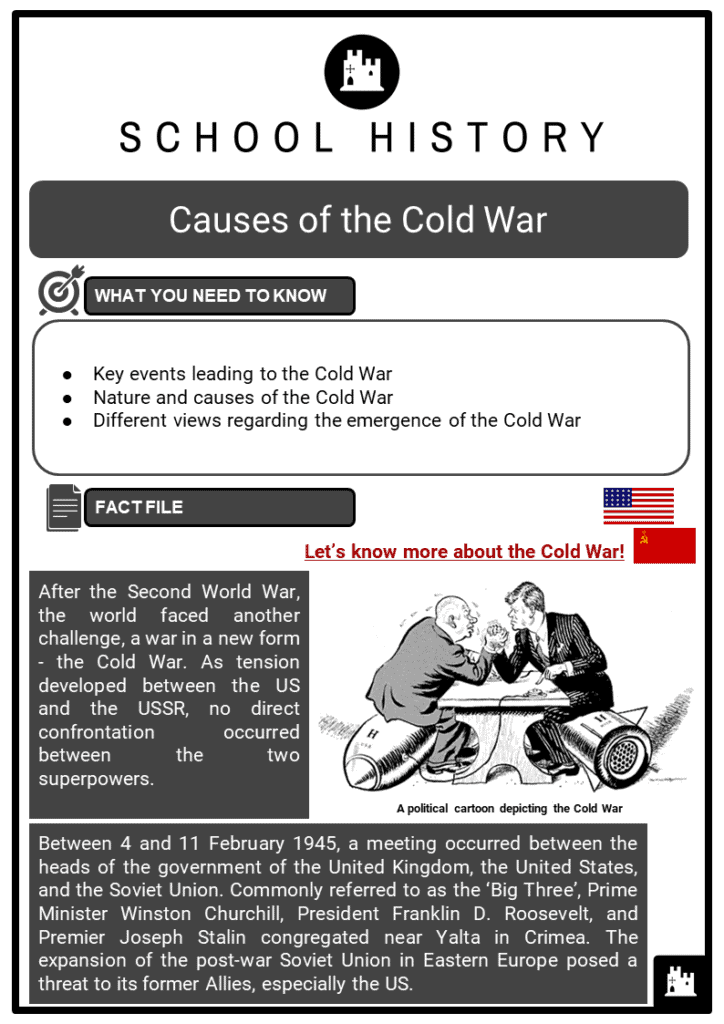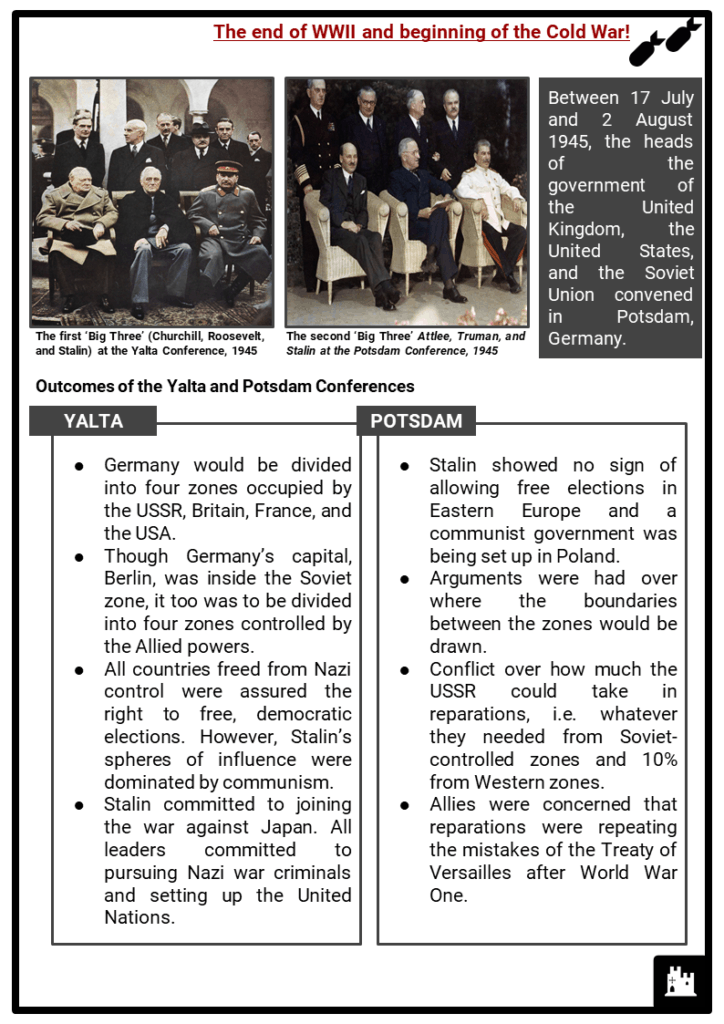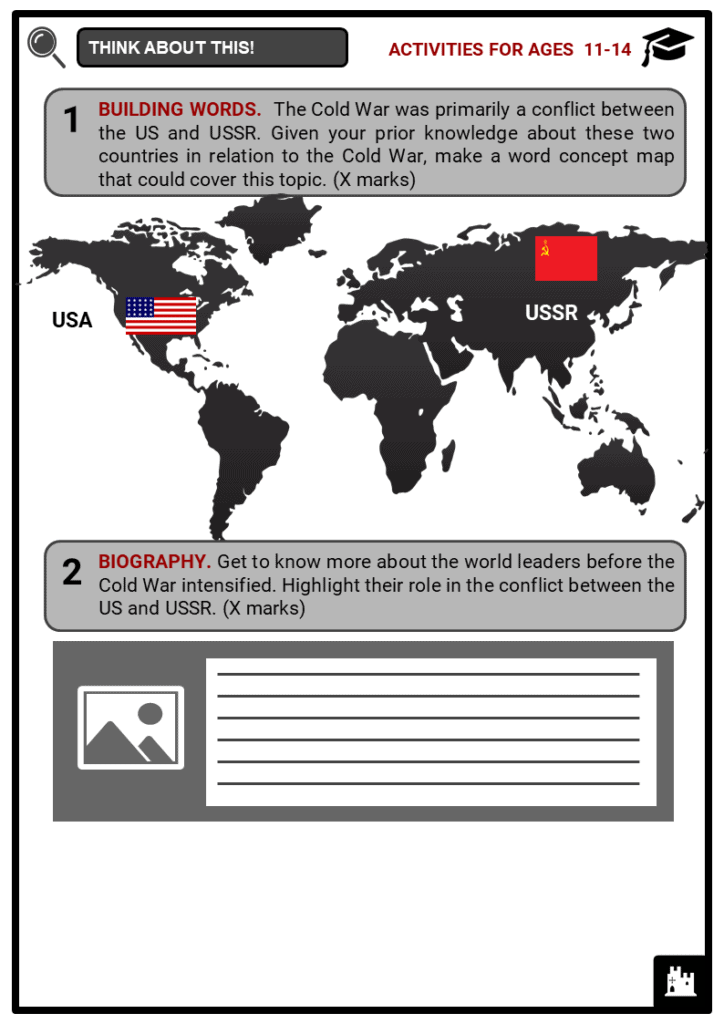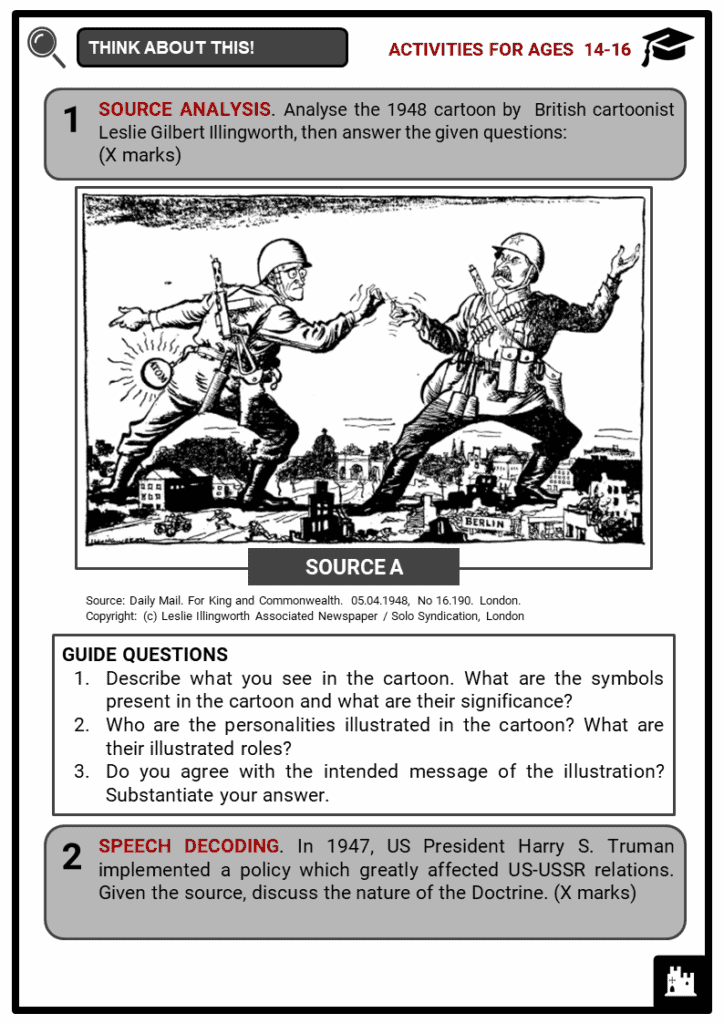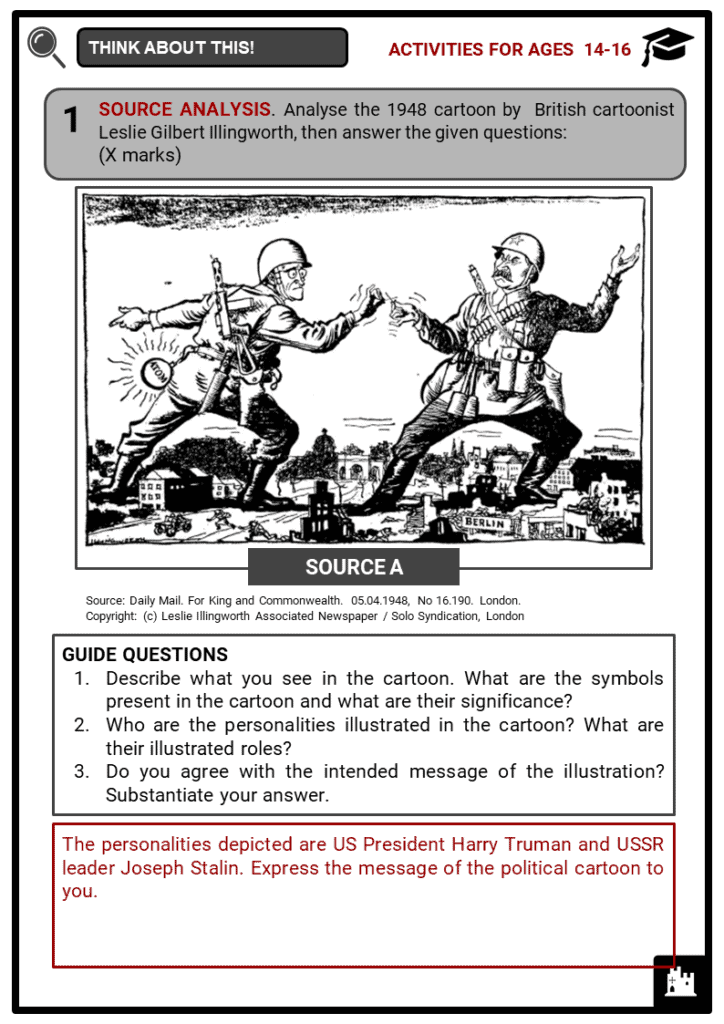Download Causes of the Cold War Worksheets
Do you want to save dozens of hours in time? Get your evenings and weekends back? Be able to teach Causes of the Cold War to your students?
Our worksheet bundle includes a fact file and printable worksheets and student activities. Perfect for both the classroom and homeschooling!
Table of Contents
Add a header to begin generating the table of contents
Summary
- Key events leading to the Cold War
- Nature and causes of the Cold War
- Different views regarding the emergence of the Cold War
Key Facts And Information
Let’s know more about the Cold War!
- After the Second World War, the world faced another challenge, a war in a new form - the Cold War. As tension developed between the US and the USSR, no direct confrontation occurred between the two superpowers.
- Between 4 and 11 February 1945, a meeting occurred between the heads of the government of the United Kingdom, the United States, and the Soviet Union. Commonly referred to as the ‘Big Three’, Prime Minister Winston Churchill, President Franklin D. Roosevelt, and Premier Joseph Stalin congregated near Yalta in Crimea. The expansion of the post-war Soviet Union in Eastern Europe posed a threat to its former Allies, especially the US.
The end of WWII and beginning of the Cold War!
- Between 17 July and 2 August 1945, the heads of the government of the United Kingdom, the United States, and the Soviet Union convened in Potsdam, Germany.
Outcomes of the Yalta and Potsdam Conferences
- YALTA
- Germany would be divided into four zones occupied by the USSR, Britain, France, and the USA.
- Though Germany’s capital, Berlin, was inside the Soviet zone, it too was to be divided into four zones controlled by the Allied powers.
- All countries freed from Nazi control were assured the right to free, democratic elections. However, Stalin’s spheres of influence were dominated by communism.
- Stalin committed to joining the war against Japan. All leaders committed to pursuing Nazi war criminals and setting up the United Nations.
- POTSDAM
- Stalin showed no sign of allowing free elections in Eastern Europe and a communist government was being set up in Poland.
- Arguments were had over where the boundaries between the zones would be drawn.
- Conflict over how much the USSR could take in reparations, i.e. whatever they needed from Soviet-controlled zones and 10% from Western zones.
- Allies were concerned that reparations were repeating the mistakes of the Treaty of Versailles after World War One.
Causes of the Cold War
- Differences in ideologies
- The United States and the Soviet Union represented two opposing systems of government. The major differences were that the Soviet Union was a communist country, which was ruled by a dictator who put the needs of the state ahead of personal human rights, whereas the USA was a capitalist democracy, which valued personal freedom and feared communism. This signalled the start of the Cold War.
- The American way of life was, and is, based upon the will of the majority, and is distinguished by free institutions, representative government, free elections, and guarantees of individual freedom, freedom of speech and religion, and freedom from political oppression.
- The communist Soviet way of life, however, was based upon the will of a minority, the state, forcibly imposed upon the majority. It relied upon terrorising and oppressing citizens, which was made possible through a controlled press and rigged elections.
- These differences in ideologies, plus the countries involved resenting each other historically, resulted in a series of events that led to the collapse of the alliance and turned the allies of the war into enemies.
- Post-war Economic Reconstruction
- Poor relations between the United States and the Soviet Union escalated even further when the Land-Lease was abruptly terminated by the United States and Russia’s request for American economic aid for the purposes of post-war reconstruction fell on deaf ears.
- During the Second World War, the US supplied much-needed war material to Allied nations through the Lend and Lease programme and this abrupt refusal did not go down well with the Russians.
- Differences between Truman and Stalin
- President Harry S. Truman (1945-1953) simply disliked Stalin and the Soviets. This is quite evident from the signing of a US foreign policy known as the Truman Doctrine, which vowed to help countries under threat from the Soviets.
- It is worth noting that the Soviet Union later issued the Brezhnev Doctrine, which decreed that the Soviet Union would intervene with force in order to protect Communism in its satellite states. One of the main issues that strained relations between the Soviet Union and the West was the threat of nuclear war.
- TRUMAN DOCTRINE. As Britain faced economic problems after the war, it played a minimal role in the reconstruction process in the Mediterranean, specifically Greece and Turkey. In March 1946, in a broadcasted speech from Westminster College in Fulton, Missouri, Winston Churchill stated that an ‘Iron Curtain’ had descended across the European continent. Joseph Stalin interpreted this as a war cry, but Truman countered it through US policies.
- Thus, the US responded with the Truman Doctrine in which the US would give financial aid to countries threatened by Communist expansion. This was also in line with the potential civil war in Greece, which could be used by the Soviets to influence the country.
- MARSHALL PLAN. In June 1947, the Marshall Plan was proclaimed. It was a European Economy Programme in which 13 billion USD was made available for the rehabilitation of European countries damaged by the war. US President Truman believed that Communism could only be stopped if Europe became wealthier through economic reconstruction. The massive economic aid programme was led by US Secretary of State George C. Marshall.
- The Soviets saw this as an imperialistic attempt by the US to influence smaller European countries.
- In addition to money, the US shipped food, supplies, and equipment to Europe until 1951. The US wanted to isolate the USSR to keep it from expanding its sphere of influence.
- Support of Proxy-wars
- Proxy wars didn’t necessarily cause the Cold War but worsened it. The two superpowers often wrestled for superiority when it came to third world countries, and supporting proxy wars in which they typically supplied and advised opposing factions in civil wars, including the Vietnam War, to the US backing the Ethiopian government and the Soviets going with next-door rival Somalia in the 1970s. This goes to show that their alignments were often arbitrary.
- US Atomic Bomb
- The Soviet Union was extremely concerned about its security after being invaded twice in the twentieth century. In 1945, America created and used the atomic bomb against Japan and the USSR was determined to create one of its own. Both the USSR and the US built up huge arsenals of Inter-Continental Ballistic Missiles (ICBMs). The United States tested a hydrogen bomb in 1952 and in November 1955, the USSR developed one too.
- After that, the US moved its bombers into Europe. In 1955, West Germany was allowed to re-arm and join NATO. Russia responded by forming the Warsaw Mutual Defense Pact with its buffer zone neighbours.
- As security was being strengthened, it led to the formation of military alliances. In April 1949, the North Atlantic Treaty Organisation (NATO) was formed. In response, the Soviets formed the Warsaw Pact.
- In September 1947, the Communist Information Bureau (Cominform) was formed. It was comprised of countries under the Soviet Bloc (Eastern European countries), which promoted international Communist solidarity. It was dissolved in 1956.
- USSR’s expansion west into Eastern Europe
- Even before the end of the Second World War, the Soviet Union had gradually extended its influence in Europe. As the war was drawing to a close in May 1945, the Soviet Union quickly solidified its control of Eastern Europe.
- The Red Army began by influencing the post-war elections. Although the non-communists could still gain some votes, most of the votes went to the Communists as the elections were neither free nor fair. Many politicians in the United States had high hopes of America working with the Soviet Union after the war and did not advocate strong resistance against Russian expansion, but this soon changed. The US government now favoured a policy of strong resistance against Russia.
- From May 1945 onwards, the situation changed. The United States became alarmed with the growth of Communism in Europe and put in place a plan known as the Marshall Plan in order to counteract the spread of communism.
- It was an economic support programme funded by the United States. They gave relief money to war-torn democratic countries to rebuild their economies. They did not give money to the Soviet Union and any of its satellite states.
- The United States’ motivation for doing this was to provide themselves with trading partners and to economically isolate the Soviet Union. The Soviet Union also formed an exclusive economic federation between all the states in the Soviet Union called COMECON. This restricted trade to within the Soviet Union. These measures to isolate the enemy and set up economic barriers helped to provoke the Cold War.
- The Berlin Crisis
- After the Second World War, Germany was divided into four zones of occupation. As per the Yalta and Potsdam Conferences, the zones were placed under the control of the United States, the United Kingdom, France, and the Soviet Union.
- In the 1950s, the Communist government of East Germany controlled and prevented its citizens from fleeing to the West. Stalin ordered the building of fences and walls to stop East Berliners migrating.
- By February 1948, the British, French, and American governments began to merge their zones economically to unify them and form a national government. In response, the Soviet Union imposed a blockade of Berlin to halt the process of unifying West Germany and to secure the Soviet-controlled territory in the eastern zone.
- The Berlin Blockade lasted for almost 20 days and became one of the major crises during the Cold War. The Soviet Union blocked Allied access to West Berlin, which resulted in shortages of commodities including food, medicine and fuel.
- The US responded with the Berlin Airlift in which hundreds of tons of supplies were dropped from airplanes.
The Blame Game
- This ensued even after the war ended as various historians argued their different points of view.
- RUSSIAN VIEW
- Most Russian historians blame British Prime Minister Winston Churchill and American President Truman. They state that Truman and Churchill instigated the war and wanted to destroy the USSR, which was just defending itself.
- TRADITIONAL VIEW
- At first, western writers blamed Russia. They said Stalin was trying to build up a Soviet empire.
- REVISIONIST VIEW
- This view was developed by Western historians who blamed America, citing their main reason as Truman’s lack of understanding of how much Russia had suffered in the Second World War.
- POST-REVISIONISTS VIEW
- This view was developed by historians with an element of neutrality. They stated that both sides were to blame for the war and that there was hatred on both sides.
- Modern historians agree, however, that the Cold War was primarily a clash of beliefs – mainly Communism versus Capitalism. The Soviet Union wanted to spread its ideology of Communism worldwide, which antagonised the Americans who believed in democracy. The acquisition of atomic weapons by America caused fear in the Soviets. Both countries feared an attack from each other and built up counter-measures.

